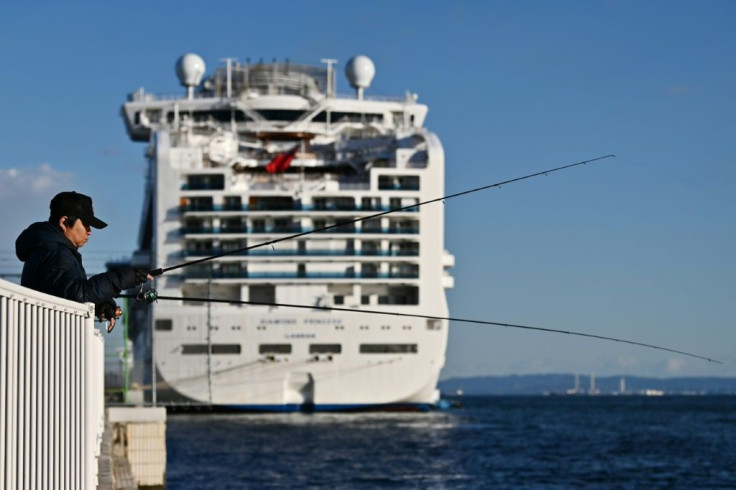Pounded By Critics, Japan Defends Handling Of Virus Outbreak

Japan faces mounting criticism for its handling of a coronavirus-afflicted cruise ship, with questions over a patchy quarantine, incremental testing and the decision to let people walk away after 14 days.
The 3,711 people on the Diamond Princess went into quarantine off Japan on February 5, after it emerged that a former passenger had tested positive for the new coronavirus.
Passengers were confined to cabins except for brief outings on deck, when they were required to wear masks and gloves and keep their distance from each other.
But doubts soon emerged about whether the measures were working. Within days, dozens of people on board were diagnosed with the virus, and by Tuesday, 542 cases were reported.
While passengers were confined to their cabins, those with balconies could sometimes be seen talking to neighbours without masks.
And crew were not quarantined, sharing working spaces, living quarters and bathrooms, and simply donning masks and gloves when interacting with passengers.
At least two government officials themselves contracted the virus while working on the ship.
Kentaro Iwata, a professor at the infectious diseases division of Kobe University, blasted the on-ship quarantine as a "major failure, a mistake".
"It is highly likely secondary infections occurred," Iwata told AFP, saying scepticism from abroad of the quarantine was "only natural".
Japanese officials have defended the approach, with Shigeru Omi, a former WHO regional head advising the government, saying the quarantine had "a very positive effect" on reducing infections.

"(The) majority of the infections, we believe, occurred before the date when the quarantine measures started," he told reporters.
That does not appear to have convinced foreign governments, which began evacuating their citizens from the ship even as the 14-day quarantine mandated by Japan neared completion.
More than 300 Americans have been evacuated from the ship, with Australia, Britain, Canada and Hong Kong all planning to repatriate citizens.
The US embassy warned that US health officials have "concluded that despite efforts of quarantine there is a high risk that passengers... have been exposed to COVID-19".
And in an indication that foreign governments do not believe the on-ship quarantine has worked, those being repatriated will undergo another quarantine of two weeks -- the presumed virus incubation period.
The criticism has put Japan on the defensive, with officials emphasising that there were no guidelines for the situation.

Other countries have simply turned away cruise ships over the virus, and Cambodia is now scrambling after welcoming a ship that turned out to have at least one infected passenger on board.
"There was no established international agreement as to how to respond to and who is responsible for and when to disembark," Omi told reporters.
"No organisation is perfect, Japan is no exception."
Michael Ryan, head of the WHO's health emergencies programme, acknowledged there "has been much more transmission than expected on the ship".
But, he added, "it is very easy in retrospect to make judgements on public health decisions made at a certain point".
Pinpointing when infections began on the ship was made harder by the slow rollout of testing, with fewer than 300 people initially tested and the pool only gradually expanded to include at-risk groups.
Japan said it was constrained by limited testing capacity, but waited days to ask the private sector for help, and only completed onboard testing of passengers a day before the quarantine ended.
And as many of those of who test positive do not have symptoms, officials concede it is hard to prove when they contracted the virus.
Despite the doubts, Tokyo will allow those who test negative in the final days of the quarantine to leave the boat, with around 500 expected to disembark on Wednesday alone.
Officials say there is little evidence that tests produce false negatives, pointing to the hundreds of Japanese evacuated from China, most of whom tested negative at the start of a quarantine and remained negative.
"As far as we know, once the test is negative, they remain negative," Takaji Wakita, director-general of Japan's National Institute of Infectious Diseases, told AFP.
Domestically, the government's handling of the crisis appears to have dented Prime Minister Shinzo Abe's popularity, already battered by a cronyism scandal.
And a recent poll found 52 percent disapproved of the government's response to the outbreak, but in Yokohama where the ship is docked, there was sympathy for those on board.
"It must be really tough," 17-year-old student Shoya Horiuchi told AFP. "I want them to hang in there."
But, he conceded, he has started to think of the virus as "a threat"
"I am a bit scared."
© Copyright AFP {{Year}}. All rights reserved.



















